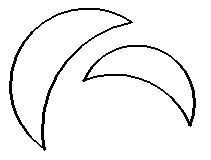- About MAA
- Membership
- MAA Publications
- Periodicals
- Blogs
- MAA Book Series
- MAA Press (an imprint of the AMS)
- MAA Notes
- MAA Reviews
- Mathematical Communication
- Information for Libraries
- Author Resources
- Advertise with MAA
- Meetings
- Competitions
- Programs
- Communities
- MAA Sections
- SIGMAA
- MAA Connect
- Students
- MAA Awards
- Awards Booklets
- Writing Awards
- Teaching Awards
- Service Awards
- Research Awards
- Lecture Awards
- Putnam Competition Individual and Team Winners
- D. E. Shaw Group AMC 8 Awards & Certificates
- Maryam Mirzakhani AMC 10 A Awards & Certificates
- Two Sigma AMC 10 B Awards & Certificates
- Jane Street AMC 12 A Awards & Certificates
- Akamai AMC 12 B Awards & Certificates
- High School Teachers
- News
You are here
An Investigation of Historical Geometric Constructions - Quadrature of the Circle
Hippocrates of Chios (born around 470 B.C.E.), not to be mistaken for Hippocrates of Cos who is the father of Greek medicine, focused much of his studies on solving the three constructions of Greek Antiquity. Although little is known about Hippocrates’ life, it is thought that he traveled from the Island of Chios to Athens to settle a lawsuit in connection with either being deceived by customhouse officers at Byzantium or having his ships looted by pirates. While settling the court issue whose outcome is unknown, Hippocrates attended lectures of Athenian scholars, provoking his interest in solving the three classical problems of Greek Antiquity. Heath notes that Hippocrates had three main contributions to mathematics:
- He was, so far as we know, the first to compile a book of Elements.
- In an attempt to square the circle he showed how to square certain classes of ‘lunes’.
- He was the first to observe that the problem of doubling the cube can be reduced to that of finding two mean proportionals in continued proportion between two given straight lines, with the result that the problem was ever afterwards attacked in the latter form. (Heath, 1963, p. 121)
As described in his second accomplishment, Hippocrates calculated the area of different types of lunes, which are regions between arcs of two circles as shown in figure 12, in his attempt to construct a square with the same area as a circle. Hippocrates calculated the area of three types of lunes, that is, a lune with an outer arc greater than a semicircle, one with an outer arc less than a semicircle, and one with an outer arc equal to a semicircle.

Figure 12: Examples of lunes.
It should be noted that Hippocrates was well aware of properties of circles, in particular that the areas of two circles are proportional to the squares on their diameters. In addition, he knew the Pythagoreans had shown that the sum of the square areas on two legs of a right triangle is equal to the square area on the hypotenuse. With this in mind, we begin interpreting Hippocrates’ method for calculating the area of a lune with an outer arc equal to a semicircle and share how to use Geometer’s Sketchpad to explore this proof.
Suzanne Harper and Shannon Driskell, "An Investigation of Historical Geometric Constructions - Quadrature of the Circle," Convergence (August 2010)




